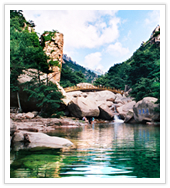Mt. Laoshan is situated at the seashore of Yellow sea,in the east of Qingdao city, with a total area of 446 km2. It is one of the national main scenic spots announced by State Council, including 9 specific tourist attractions—Jufeng, Dengying, Liuqing, Taiqing, Shangqing, Yangkou, Qipanshi, Beijiushui and Hualou, 5 scenic spots being restored, such as Shazikou etc and some other spots around the mountain along the coast. Jufeng(the highest peak), 1132.7m above sea level is the highest among the mountains along the national coastal line of over 10,000 miles. Mt. Laoshan also bears the name as “No 1 coastal mountain”, “land for supernatural being” or “fascinating and blessing place” which makes it a famous scenic spot for sightseeing, spending summer holidays, resting and recuperating.
Thrusting from the sea, Mt. Laoshan is linked with the sea, extending in four directions from its center—Jufeng (the highest peak), low, flat with ranges running to far distance in the west; high, steep and towering with fairy caves, stones, deep valleys and spring waterfalls in the east. The coastal line is winding around the mountain with various rocks, islets and bays staggered. The famous “12 sceneries”—Jufeng Xuzhao (rising sun in the morning on the highest peak), Taiqing Shuiyue (a bright moon in spring water of Taiqing Palace), Haiqiao Xiandun, Longtan Penyu ( the deep linns splashing sprays), Mingxia Sanyi (rays of sunshine), Naluoyanku (rock cave), Yundong Pansong (pine tree on the rock), Yanpu Chaoyin (waterfall with sound of tide), Weizhu Mingquan (spring with sound), Jiushui Mingyi (crystalline ripples in nine rivers), Hualou Dieshi (various stones), make people acclaim as the peak of perfection.
|
 |
The weather in Mt Laoshan is moderate with plenty of rainfall. The ancient trees inside and outside the temples and palaces, such as cypress in Han Dynasty, elm in Tang Dynasty, gingko in Song Dynasty and camellia in Ming Dynasty etc are known to all, far and near. |
As a famous mountain of Taoism culture, Mt. Laoshan is rich in history. It is also the place where Faxian, a well-known Buddhist in Jin Dynasty landed after getting Buddhist scriptures back from India, serving as the headstream of orthodox Buddhism in eastern part of Shandong. Therefore it finds favor in refined scholars’ eyes in various Dynasties. The stories “Fragrant Jade” and “Laoshan Taoist” in the book “Liaozai” written by Pu Songling in Qing Dynasty are well known to all. The palaces and temples formally opened to the outside are Taiqing Palace, Shangqing Palace, Mingxia Cave, Taiping Palace, Huayan Temple, weizhu Nunnery and Hualou Palace etc.
Natural resources are abundant in Laoshan Mountain area, including well-known Laoshan mineral water and various aquatic products which lead people to endless aftertastes.
With the facilities being perfected as well as the sincerity of services proved by the sea and mountain, we welcome you! |

